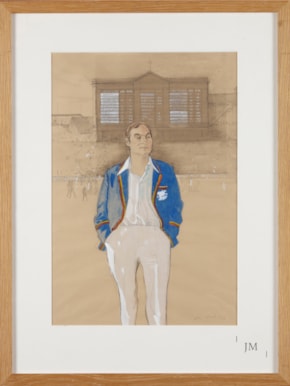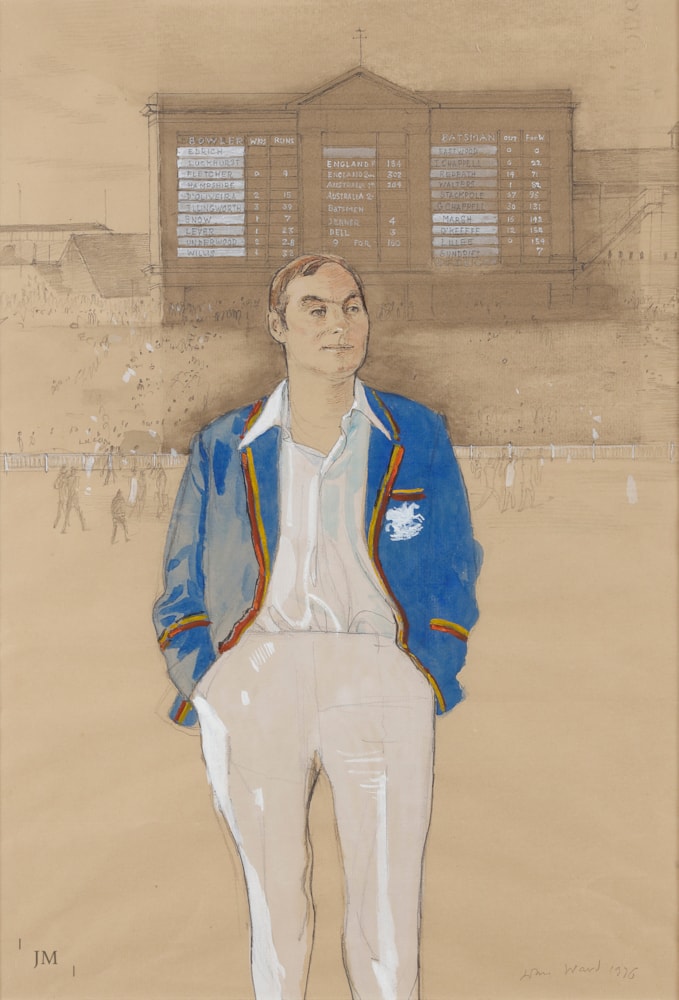John Ward ( 1917 - 2007 )
John Edrich, MBE


John Edrich, MBE
pencil and watercolour with gouache heightening on brown paper
18 x 12 in.
framed size 25 x 19 in.
signed and dated 1976
This charming study of the famous Surrey and England batsman John Edrich (1937-2020) seems to relate to a series of at least six portraits by John Ward of England Test cricketers of the same generation, which include Tony Greig, Bishan Bedi and Clive Lloyd. The originals of these have not been traced and are known from lithographs signed by the artist (see British Sporting Art Trust website). The Raymond Illingworth one shows him in the same setting as our one of Edrich, at the Sydney Cricket Ground in February 1971, at the end of the seventh Test in the 1970-71 Ashes series which England won. In the background is the famous scoreboard with its pediment and distinctive headings of 'BOWLER' and 'BATSMAN' on the left- and right-hand sides respectively. (This was replaced in 1983.) Edrich is shown at the top of the batting order, and the only artistic license appears to be that Ward could not find space for a full team and so the name of the great Alan Knott is missing. It has been possible to identify the setting by the inclusion in the Australian line-up of Ken Eastwood, a 'One Test Wonder', who was out for a duck in the second innings, as faithfully recorded by John Ward! Why the drawing is dated 1976 is unclear, but perhaps Ward painted it at Edrich's request and to show him as he had done for Ray Illingworth, after winning the Ashes in Australia.
John Ward was a well-known society artist from Kent, and is best known for teaching the rudiments of watercolour painting to Prince Charles on a visit to Venice in 1985. Other than the series of England cricketers described above, he is not known to have had any particular affiliation with the game. He trained at the Royal College of Art from 1936 under the painter-illustrator Barnett Freeman, who taught him in not only the technical aspects of his craft, but instilled a strong sense of work ethic in the young artist, while deriding the ‘gentlemen’s hours’ kept by many of his students. On leaving the RCA in 1939, Ward began seven years’ service in the Royal Engineers, helping to design and build concrete pillboxes along the Kent Coast. It was his experience of the Kentish landscape at this time that drew Ward back to live in Kent after the war, where he bought and Elizabethan farmhouse near Ashford.
After a brief stint teaching at the Wimbledon School of Art, Ward worked for Vogue painting pen and wash portraits of glamorous models and society figures, and quickly built up a reputation that allowed him to start a private practice. In 1962 he was invited by the Queen to Balmoral to sketch scenes of family life, shooting parties, picnics and favourite parts of the castle. Later in 1981, as a guest at the Prince of Wales and Lady Diana Spencer’s wedding at St Paul’s Cathedral, he made sketches of the ceremony from the choir for paintings which entered the couple’s collection. During the 1950s he exhibited with success at the Royal Academy and was elected an Associate of the RA in 1957, and then as a Royal Academician in 1966. Over the years he played an important role in the Academy’s activities, serving for a time as a trustee.
John Ward’s son Toby Ward (b.1965) is also an artist, who has accompanied the King (then the Prince of Wales) on royal tours, as well as commissions for the National Trust, Royal Opera House, The Ritz and the Open Championship at Royal St George’s, Sandwich.

